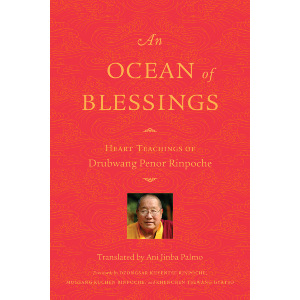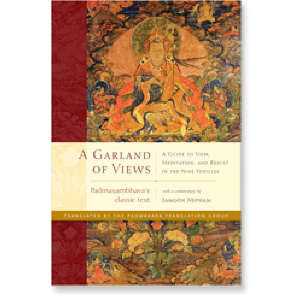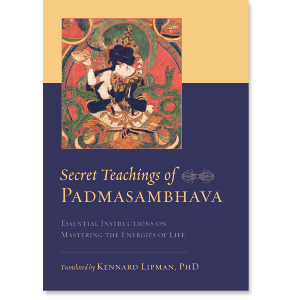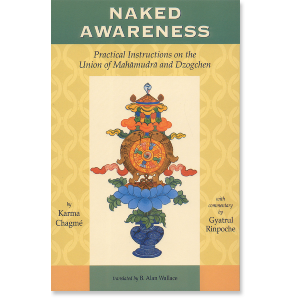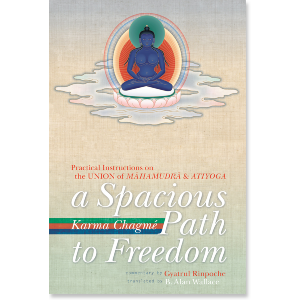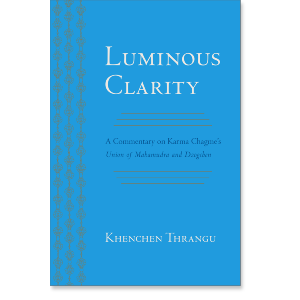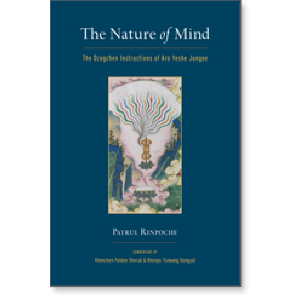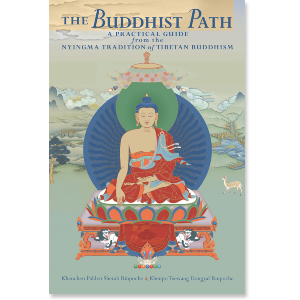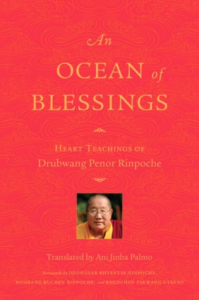We have excerpted the chapter “Samsara” from An Ocean of Blessings: Heart Teachings of Drubwang Penor Rinpoche here. This inspiring work is the first available collection of teachings by one of the most well-known Nyingmapa masters of the twentieth century, His Holiness Penor Rinpoche.
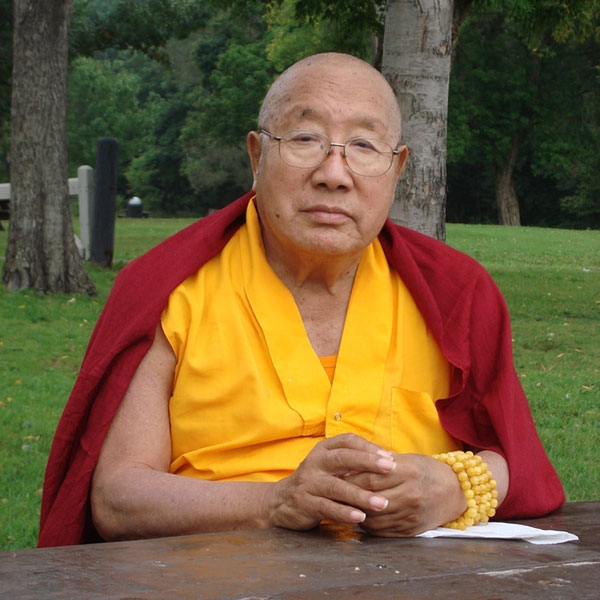

Penor Rinpoche
His Holiness Penor Rinpoche (1932–2009) was one of the most well-known Nyingma and Dzogchen masters of the twentieth century. Rinpoche was the third head of the Nyingma school of Tibetan Buddhism and the eleventh throne-holder of the Palyul lineage. Considered an incarnation of Vimalamitra, Rinpoche received his full spiritual training in Tibet before escaping to India in 1959. He subsequently established Namdroling Monastery in Southern India and also taught extensively throughout the world. Rinpoche had many Tibetan and international students, and in the 1980s he recognized the first Western female reincarnate lama, Jetsunma Ahkon Lhamo (Alyce Louise Zeoli).
Penor Rinpoche
-
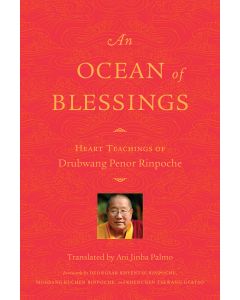 An Ocean of Blessings$24.95- Paperback
An Ocean of Blessings$24.95- PaperbackForeword by Dzongsar Jamyang Khyentse
Translated by Ani Jinba Palmo
By Penor Rinpoche
GUIDES
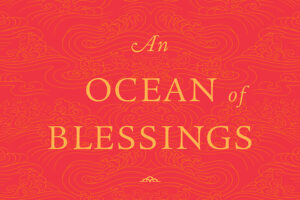
Samsara | An Excerpt from An Ocean of Blessings
Everyone in this world wants perfect comfort and happiness. Not a single being wants to suffer. If we exert ourselves, we may be able to create a comfortable situation, but no matter what temporary comfort and happiness we achieve through our efforts and hardships, it’s never steady or permanent. However, by practicing the Dharma, we can achieve the unsurpassed, ultimate bliss that liberates all from the sufferings of samsara and leads to perfect happiness.
Having been born in this world, we are attached to samsara, and being constantly preoccupied with our day-to-day survival, we experience a lot of hardship as we try to gather the necessary resources to spend our life in comfort. And so the years pass without our really accomplishing anything of lasting value. If we succeed in doing something or acquire some knowledge, we feel very arrogant about it, and when we don’t succeed in doing what we wish, we worry about it day and night, and the stress of our worries makes us sick. Once we are sick, we focus on the illness, which only causes us to suffer even more. There is no benefit at all in being worried. It doesn’t accomplish anything, nor does it purify our obscurations. Worry also doesn’t help us acquire more wealth; it only increases our disturbing emotions and makes it that much more difficult for us to succeed. When our mind thinks too much, we accumulate a certain type of mental karma, and we’re so accustomed to it that we can’t stop worrying. Even when we know that worrying doesn’t help, we still can’t stop. So even though we need to engage in worldly jobs for the sake of our livelihood, we shouldn’t be attached to them, but should cut our grasping to them.
Of course, it’s important to take care of your finances and have some resources to support yourself, but you should not concentrate only on that. You should be satisfied with whatever you need for your livelihood and not keep amassing more and more. Remind yourself that between this life and your next, your next life is much more important. It’s nice to have a few material belongings, but it’s very rare for us to be content with what we have. Not only that, it’s also difficult to keep what we have. People keep making more and more money, yet never feel that they have enough. According to the Dharma, if we possess wealth, we need to know how to use it. It’s beneficial to have enough to support ourselves, not for pleasure’s sake but so that we can focus more intently on our Dharma practice. What we really need is the Dharma, not more wealth, so it is best to concentrate on Dharma practice and be content having just enough to live on. Just look at how animals manage to survive. For example, in Tibet there is an animal that looks like a squirrel. During the summer it collects dry leaves and lines an underground burrow with them. Then it collects just enough of a nutritious type of grass called dronma to last the winter. It doesn’t seek a fancy house or want more just for the sake of having more but is content with just what it needs to survive.
Nowadays, many Tibetans have the freedom to practice Dharma and are not tied down by a difficult financial situation like people in the West. In North America and Europe, you really need to have a job or you can’t support yourself, so it’s best not to waste your money but use it wisely. Many Tibetans go through a lot of trouble to get to the United States and to repay the debts they incurred in the process, and often they don’t even have proper visas or permits. Yet, in spite of all that, they still manage to find a job, save money to pay their debts, and send some home to support their families. Most Americans, however, are born with so many advantages that they don’t realize how fortunate they actually are. So please don’t waste your money—use it for Dharma practice.
During our entire life we have been involved in so many activities, but if you really think about it, the result of wealth and fame is only temporary; it doesn’t benefit our next life whatsoever but only causes negative karma. We may possess all the riches on earth, but when we die there is not so much as a blade of grass that we can take with us. On the other hand, our negative karma follows us like a shadow, even through the bardo after we die.
Now that you have obtained this precious human body that is so hard to find, try to make it meaningful by truly taking advantage of this rare opportunity. Worldly activities such as attaining high status, accumulating property and wealth, and so forth really have no benefit whatsoever, so please don’t waste this precious opportunity. We may command a retinue of thousands of attendants and soldiers, but at the time of death we have to go alone, and at that time the only thing that can help is our own Dharma practice. So, from now on, don’t get carried away by your thoughts and negative emotions but control and reduce them, supplicate the Three Jewels, and diligently apply yourself to your practice. I assure you that if you truly concentrate on your Dharma practice, it is possible to reach the highest levels of realization in this very lifetime, so you really don’t need to wander in samsara anymore. But sadly, we humans tend to look at the world upside down and neglect what’s most important, while perceiving trivial matters as the main purpose in life.
Once, when I was teaching in Taiwan, I told some students not to be attached to their jobs, but they said, “If we don’t do our work, then who will?” But Taiwan won’t come to a standstill just because a few people stop working. Actually, it’s good if samsara becomes empty; if all beings attain liberation, we don’t need samsara. We’ve been wandering here for countless lives and experience nothing but suffering. Our whole life is nothing but hardship and misery, but we still haven’t accomplished anything, and even though we may plan a happy and comfortable life with our family, when the time comes to retire we say to ourselves, “Now I’m done with my job, and I’m going to relax.” But instead, when we retire we worry about our savings, our health, and a thousand other things. We still hope that we can be happy and peaceful but end up dying without fulfilling our wishes, and often we experience a terminal illness that causes intense suffering. On the other hand, when bodhisattvas and realized masters die, it is always in a happy state of mind because they have attained freedom and are happy to go to the pure lands. They are not afraid but actually enjoy death.
SNOW LION NEWSLETTER ARCHIVE
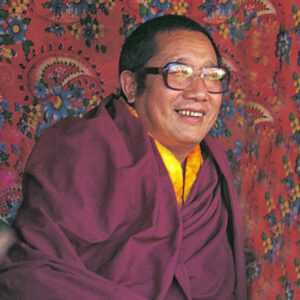
Kalachakra 1997 For World Peace: His Holiness Penor Rinpoche
Kalachakra 1997 For World Peace: His Holiness Penor Rinpoche
| The following article is from the Spring, 1997 issue of the Snow Lion Newsletter and is for historical reference only. You can see this in context of the original newsletter here. |
Rochester, New York July 22-24, 1997
Something remarkable is happening in Rochester, New York. His Holiness Penor Rinpoche, the head of the Nyingma school of Tibetan Buddhism, will come to Rochester from India to give the Kalachakra Teachings and Empowerment. Penor Rinpoche has been invited by Ven. Ayang Rinpoche, founder of both the Amitabha Foundation and Rochester's Drikung Institute. Additionally, they plan to have one week of Kalachakra teachings will precede the empowerment and a week of retreat will follow.
Events are shaping up that will communicate the spirit of the Dharmato the non-Buddhist community. The University of Rochester's Memorial Art Gallery have invited the Namgyal monks to create the Kalachakra Sand Mandala during a seven-week exhibit in May and June, 1997. School Without Walls, one of Rochester's high schools, is making Tibet the theme of its 1996-97 academic year. In May, students from the school, working with the monks, will make a children's mandala utilizing their own symbols to express the common aspiration to happiness of a diverse community. The business community, a local hospital, and the interfaith community are all planning seminars or lectures related to the healing spirit of this empowerment. Rochester's media will provide extensive coverage and community leaders will take part.
The empowerment will take place in the heart of downtown Rochester on the falls of the Genesee River.
For more information, contact: Frank Howard, Amitabha Foundation, 45 Knolltop Drive, Rochester, NY 14610, 716-454-3644, [email protected]
Related Books by Penor Rinpoche
| The following article is from the Autumn, 1993 issue of the Snow Lion Newsletter and is for historical reference only. You can see this in context of the original newsletter here. |
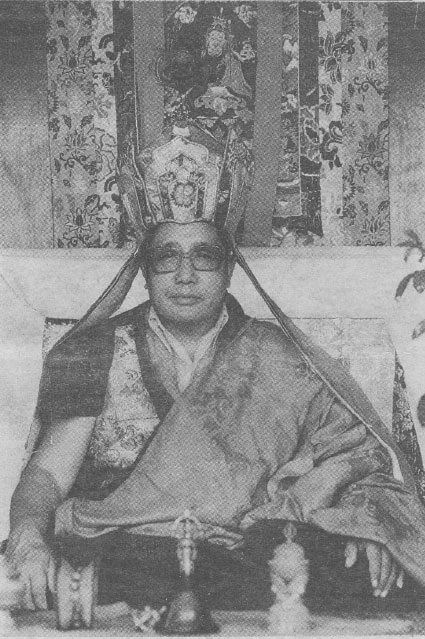
Kyabje Pema Norbu Rinpoche
On April 23,1993, His Holiness the Dalai Lama confirmed Kyabje Palyul Dubwang Pema Norbu Rinpoche as the new head of the Nyingma lineage of Tibetan Buddhism. The post became vacant after Kyabje Dilgo Khyentse Rinpoche passed away on September 28, 1991. The new Nyingma head had an audience with His Holiness the Dalai Lama in Dharamsala on June 5, 1993.
Kyabje Pema Norbu Rinpoche, popularly known as Penor Rinpoche, was elected to succeed Dilgo Khyentse Rinpoche by a gathering of lamas and abbots belonging to the Nyingma tradition in Bodh Gaya on January 9,1992. However, at that time Rinpoche was on a visit to Tibet. On his return, Rinpoche accepted the leadership at another gathering of Nyingma lamas, during the Nyingma Great Prayer Festival held in Bodh Gaya on January 3, 1993. Penor Rinpoche heads the Namdroling Monastery in Lugsung Samdubling settlement, Bylakuppe. You can read about the Palyul Nyingma lineage in The Garland of Immortal Wish-Fulfilling Trees.
...| The following article is from the Winter, 1990 issue of the Snow Lion Newsletter and is for historical reference only. You can see this in context of the original newsletter here. |
Shortly after construction of the Potala Palace in Lhasa began, an incarnation of the great translator Variocana was born into the ancestral family of King Tritson Duetsen. At an early age he was recognized as a terton, a treasure discoverer, destined to discover specific texts hidden by Padmasambhava in the eighth century. Enthroned at the end of his tenth year as Terton Migyur Dorje, he became a prolific terton recovering twelve volumes of termas before passing away at the age of 23.
The Namcho terma of Migyur Dorje became the main practice of the Palyul Lineage of the Nyingma school when its monastery was founded in the late 1600s by Vidhyadhara Kunzang Sherap, a student of Terton Migyur Dorje. In this lineage the kama and terma traditions, as well as Mahamudra and Dzogchen, are practiced together like two streams flowing into one great river. The terma treasures of nine different Tertons are included in the Palyul lineage, namely Migyur Dorje, Karma Lingpa, Ratna Lingpa, Jigme Lingpa, Orgyen Terdak Lingpa, Ngadhak Ngang, Lama Gongadu, Mati Ratna, and Rigdzin Jetsun Nyingpo. Over time the Paylul Monastery grew to be one of the six great Nyingma mother monasteries of Tibet. With the invasion of Tibet by the Chinese in the late 1950s, His Holiness Pema Norbu Rinpoche, the eleventh throne holder, was forced to flee with a handful of monks and relocate in southern India. (Snow Lion has published the book about the Palyul Nyingma Lineage. The Garland of Immortal Wish-Fulfilling Trees is available for $15.95).
Today there are over 500 monks at Palyul Namdroling Monastery in Bylakuppe, India. Inspired by the vision and efforts of His Holiness Pema Norbu, monks train in traditional Nyingma practices of ritual, dance, study and meditation, including jaling (traditional monastic music).
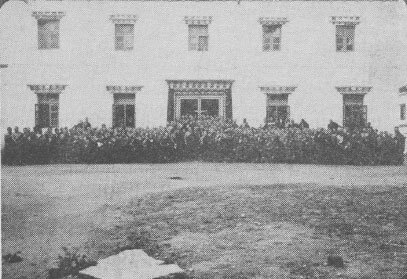
Palyul Namdroling Monastery
Nearly 200 monks are now studying at the Scholastic College. The monks rise at 5 AM and study until breakfast at 7 o'clock. Classes are held six mornings a week from 8:30 to 10:30. In the afternoon they engage in debate and in the evening study until 9 PM. After completing the nine year program and passing a final exam, they are awarded the tide Achyara (equivalent to a M.A.). In order to become a Khenpo (equivalent to a Ph.D.) the candidate must examplify stable moral conduct and undertake research culminating in a thesis paper. Once both of these have been assessed, it is up to His Holiness to confer the title of Khenpo. As Khenpos and Achayaras the monks are sent to Nyingma and Kargyu monasteries throughout India, Nepal, and Bhutan to teach.
The remaining monks in residence in the zhungtra (monastery) are responsible for upholding the traditions of the Tibetan Nyingma doctrine. In addition to the monthly full and new moon rituals, and tenth and twenty-fifth day tshog offerings, they perform week long accomplishment ceremonies two or three times a year. These involve the continuous repetition of a specific mantra throughout the ceremony. At the Tibetan New Year an accomplishment ceremony has been performed for nearly thirty years alternating between the recitation of Guru Siddhi and Mani mantra. It is said that if you participate you recieve the benefit of 100 million mantras. Occasionally during the ceremony chosmen (dharma medicine) may also be made. Medicinal herbs are mixed and blessed by the power of the practice being performed. This medicine has the power to alleviate sicknesses that ordinary medicines cannot help.
The monks of Palyul Monastery are taught to read and write and given a basic Buddhist education. Once a year they are given the op-portunity to undertake one-month retreats on Ngondro, Tsalung (breathing and yogic exercises) of Dzogchen. After years of training in the monastery a monk may enter into the traditional three-year tantric retreat and become a Dorje Lobon after completing the retreat. Twelve monks have completed the three year retreat so far and twenty-two have just begun a new one.
Nyingma traditional dance is a special feature of the Palyul tradition. In the late afternoon monks practice new dances in the courtyard of the monastery. There are peaceful and wrathful dances, there are dances to please Padmasambhava and to bring auspiciousness. All of the dances are the original gestures discovered by Tertons according to their visionary experience. They are for eliminating famine, disease, or unwanted incidents and obstacles. It is said that by seeing the kama dances incurable diseases can be cured.
Recently His Holiness enabled twenty-six lay people to learn the traditional Ling Gesar dances by bringing a teacher from Orissa, India to train the young dancers. He organized both the instruction and costumes. Thirteen different types of dances are now regularly performed at the monastery. The dances are the mind treasure of Mipham Rinpoche and are an offering to King Ling Gesar.
His Holiness is both the spiritual and financial mainstay of the monastery. He personally supervises the education of thirteen Tulkus in residence, eleven of whom are incarnations of lamas from the Palyul lineage. They are being trained to become the spiritual heads of monasteries in Tibet, Nepal, and India. His Holiness is the Master of Ceremonies for all monastic rituals and frequently travels to branch monasteries and Dharma centers throughout the world. He also oversees the construction of new buildings and supervises all other activities of the monastery, including an old people's home for lay Tibetans without family or relatives.
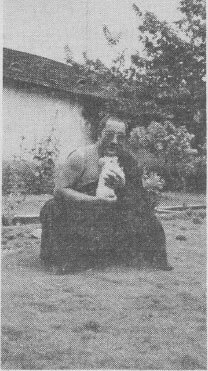
H.H. Pema Norbu Rinpoche
His Holiness' favorite pastime is spending time with animals. Next to his house is a beautiful garden inhabited by swans, exotic birds, a minature deer and numerous cats and dogs. One of the dogs, named Sonam, follows His Holiness everywhere including the shrineroom where he sits behind His Holiness' Dharma throne. In the reception room next to His Holiness' seat is a box containing a small white mouse that His Holiness acquired in Singapore. There are many stories of his great kindness to animals and of his going to great expense to bring animals back from Tibet and Europe.
Palyul Namdroling Monastery, nestled in the sandalwood forests of southern India, is a source of hope and inspiration for all Dharma pracitioners. Currently the monastery is building new classrooms and dormatories for the Scholastic College, in order to provide better facilities for its students. There are plans to build retreat compounds for lay people who are interested in doing long retreats. The Palyul lineage, which thirty years ago appeared to be on the verge of exinction, is alive and flourishing in southern India.
Anyone interested in visiting Palyul Monastery should write the Secretary for further information. A 'Special Permit' is required from the Indian government in order to visit for more than a few days. Contact: The Secretary, Nyingmapa Monastery, Aralikumari, P/O Bylakuppe 571104, Dist. Mysore, Karnataka, Southern India.
...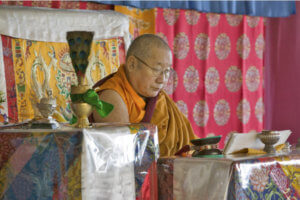
Kunsang Odsal Palyul Changchub Choeling
The following article is from the Autumn, 1987 issue of the Snow Lion Newsletter and is for historical reference only. You can see this in context of the original newsletter here.
The World Prayer Center
the Fully Awakened Glorious Dharma Place of Absolute Clear Light
Of the many lineages which have come to the West, the Palyul lineage is one of the most recent and least known. Palyul was one of six major monasteries of the Nyingma and was the practice site of many great bodhisattvas: both the practice cave of Yeshe Tsogyal and the Sangdag Secret Accomplishment cave of Padmasambhava are found there. Many images of Vajrapani and the syllable Hung are found imprinted in the rocks around the monastery.
Establishing Palyul Monastery
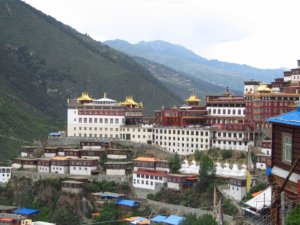
Author NoGhost From Wikimedia Commons, the free media repository; License https://creativecommons.org/licenses/by-sa/4.0/deed.en
In 1665, E.E (Lhachen Jampa Phuntsog) the first dharma king of Dege invited Vidyadhara Kunzang Sherab, (b. 1636 C.E.), the dharma regent of both Karma Chagme Rinpoche and Terton Migyur Dorje as well as the owner of numerous termas, to head Palyul Namgal Changchub Choeling, a newly constructed monastery.
Having received the title of Vajra Acharya from Terton Migyur Dorje as well as his prophecy that this monastery . . .
will become an exhaustless source of dharma, propagating the Nyingma doctrine...
Kunzang Sherab took charge of the monastery. In this endeavor, he was assisted by his sister, Genyenma Ahkon Lhamo, who was also a direct student of Migyur Dorje.
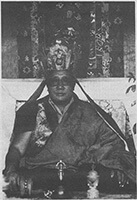
The Third Drubwang Pema Norbu ("Penor") Rinpoche
With the passage of time, the lineage continued to flourish and prosper. The main monastery grew to house over 800 monks while the total number of monks practicing in branch monasteries and retreat centers numbered over 100,000. (List of Throneholders of Palyul Monastery.)
Living the Dharma in Exile
At the time of the destruction of the monastery and community by the Communist Chinese in 1959. His Holiness Padma Norbu (Penor) Rinpoche, the eleventh throneholder of the Palyul lineage, managed to escape to India with only twelve followers. Here he began the arduous process of building a new monastery.
prominent Nyingma lamas came to give further teachings which deepened ties to traditional Dharma and particularly to the Nyingma school.
On the other side of the globe: In Washington, D.C., in the summer of 1982 a group of twelve people began to meet once a week in order to pray for the world. They were not affiliated with any particular religion or tradition, but were united only by their desire to be of service and the belief that they could somehow be effective.
At their request, Catharine Burroughs began to lead the group and give regular teachings in meditation and contemplative prayer. By the next spring, several more classes had begun.
Rinpoche found that in philosophical outlook and in much of their practice, they already adhered to the essence of the Buddhas' teaching
Through an amazing set of circumstances, the business manager of Palyul Namdroling monastery, Kunzang Lama, visited the Center in the Fall of 1984. As a result scores of young monks and refugee children received sponsorship by Center members and area residents. The Center also began to sell Tibetan carpets made at the monastery. This marked the beginning of their relationship with Palyul Namdroling and H.H. Penor Rinpoche.
The next spring, His Holiness accepted an invitation for his first visit to the West and included a short visit to Washington. During that time Rinpoche talked with the teachers and members of the Center and found that in philosophical outlook and in much of their practice, they already adhered to the essence of the Buddhas' teaching:
"Compassion for all life and meditation on the essential transcendent nature of all phenomena."
After that visit, the teachings and practices of the group became totally Buddhist as this system so perfectly fit the goals and aspirations of the Center as well as its members. Shortly thereafter, several other prominent Nyingma lamas came to give further teachings which deepened ties to traditional Dharma and particularly to the Nyingma school.
As the first Western Palyul Dharma center, Palyul Changchub Choling is the sight of His Holiness' throne and the seat of the Palyul lineage in the West.
A Palyul Dharma Center in the West
In the meantime the membership and activities continued to grow until a large facility was purchased in 1985. Located just outside of Washington, D.C. and situated on eight acres surrounded by state parks and forests, the center is a beautiful place for practice and study of Dharma.
In the spring of 1987, Catherine and Michael Burroughs visited H.H. Penor Rinpoche at the monastery in South India. During that visit, he formally accepted the center as a Palyul dharma center and gave it the name Kunzang Odsal Palyul Changchub Choling, the Fully Awakened Glorious Dharma Place of Absolute Clear Light.
The First Western Female Tulku
At that time, His Holiness also recognized Catherine as the incarnation of Genyenma Ahkon Lhamo. He stated that during that lifetime, Ahkon Lhamo was recognized as a primordial wisdom dakini who demonstrated many miraculous signs of accomplishment and was still known throughout Kham. Thus, Catherine became the first Western female tulku.
As the first Western Palyul Dharma center, Palyul Changchub Choling is the sight of His Holiness' throne and the seat of the Palyul lineage in the West. While Jetsunma continues to be the main teacher, other lamas such as the Ven. Gyaltrul Rinpoche and the Ven. Khenpo Rinpoches Palden Sherab and Tsewang Dongyal continue to visit regularly, giving teachings, empowerments, and transmissions.
Our commitment is to do all that we can for the upliftment of all life and the liberation of minds and hearts from the ravages of anger, greed, and delusion.
At the heart of the center's activities is the maintenance of a round-the-clock vigil of prayer and meditation for the earth. The members have been continuously practicing in two-hour shifts since April of 1985.
Jetsunma has stated,
"Our commitment is to do all that we can for the upliftment of all life and the liberation of minds and hearts from the ravages of anger, greed, and delusion. We believe that this must be the foundation of any real change or lasting peace on this earth. We will continue this vigil until that goal is achieved. The doors to the prayer room will always remain open to anyone who shares in this commitment."
In the summer of 1988, H.H. Penor Rinpoche returned to America for an extended tour. He visited Ven Gyaltrul Rinpoche's temple, Tashi Choeling, in Ashland, Oregon to give the Nyingma Kama empowerments and transmissions. In the fall, he planned to visit Palyul Changchub choeling outside of Washington, D.C. to give the empowerments of the Rinchen Terdzod, a collection of all the major revelations which the Padmasambhava left in Tibet. This will be first time the Rinchen Terdzod has been given in the west and it is also the first time His Holiness has given this teaching in this lifetime. Those interested in attending the Rinchen Terdzod should contact P.C.C.
The stories of the dedication, perseverance and miraculous accomplishments of great bodhisattvas are very inspiring to those endeavoring to establish Dharma in the East.
At the request of H.H. Penor Rinpoche, the history of the Palyul lineage in Tibet and India was written down and translated. Snow Lion will soon publish,
A Garland of Immortal Wish-fulfilling Trees.
This is a complete account of the lives of the eleven throne holders plus other lamas, such as Karma Chegmed and Migyur Dorje who have contributed to the founding and flourishing of the Palyul lineage. The stories of the dedication, perseverance and miraculous accomplishments of great bodhisattvas are very inspiring to those endeavoring to establish Dharma in the East. This long overdue account of one of the major lineages of the Nyingmapa school will be welcomed by practitioner and scholars alike.
For more information
Click on the following links of interest:

His Holiness Penor Rinpoche (1932–2009) was one of the most well-known Nyingma and Dzogchen masters of the twentieth century. Rinpoche was the third head of the Nyingma school of Tibetan Buddhism and the eleventh throne-holder of the Palyul lineage. Considered an incarnation of Vimalamitra, Rinpoche received his full spiritual training in Tibet before escaping to India in 1959. He subsequently established Namdroling Monastery in Southern India and also taught extensively throughout the world. Rinpoche had many Tibetan and international students, and in the 1980s he recognized the first Western female reincarnate lama, Jetsunma Ahkon Lhamo (Alyce Louise Zeoli).
Related Books
$21.95 - Paperback
By: Khenpo Tsewang Dongyal Rinpoche & Khenpo Tsewang Dongyal & Patrul Rinpoche & Khenchen Palden Sherab
$21.95 - Paperback
By: Khenpo Tsewang Dongyal Rinpoche & Khenpo Tsewang Dongyal & Khenchen Palden Sherab
Karma Chagmé was a major lineage-holder of the Karma Kagyu tradition of Tibetan Buddhism, and his writings have also become central to the Payul Nyingma order, making him an ideal figure to integrate two of the great meditation systems of Tibet: Mahamudra and Atiyoga.
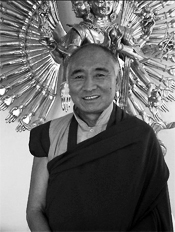
Khenpo Tsewang Dongyal Rinpoche, along with Khenchen Palden Sherab Rinpoche, is a founder and director of Padmasambhava Buddhist Center based at Padma Samye Ling in upstate New York. PBC is a worldwide Buddhist meditation and study network that includes local centers as well as retreat centers and monastic institutions.
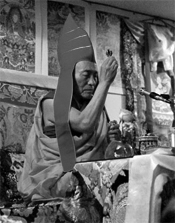
Khenchen Palden Sherab, along with Khenpo Tsewang Dongyal, is a founder and director of Padmasambhava Buddhist Center based at Padma Samye Ling in upstate New York. PBC is a worldwide Buddhist meditation and study network that includes local centers as well as retreat centers and monastic institutions.
Related Books and Media on the Palyul Lineage
Penor Rinpoche's Ocean of Blessings
Hear translator Ani Jinba Palmo discuss the 2017 release of Penor Rinpoche's first book in English, An Ocean of Blessings.

